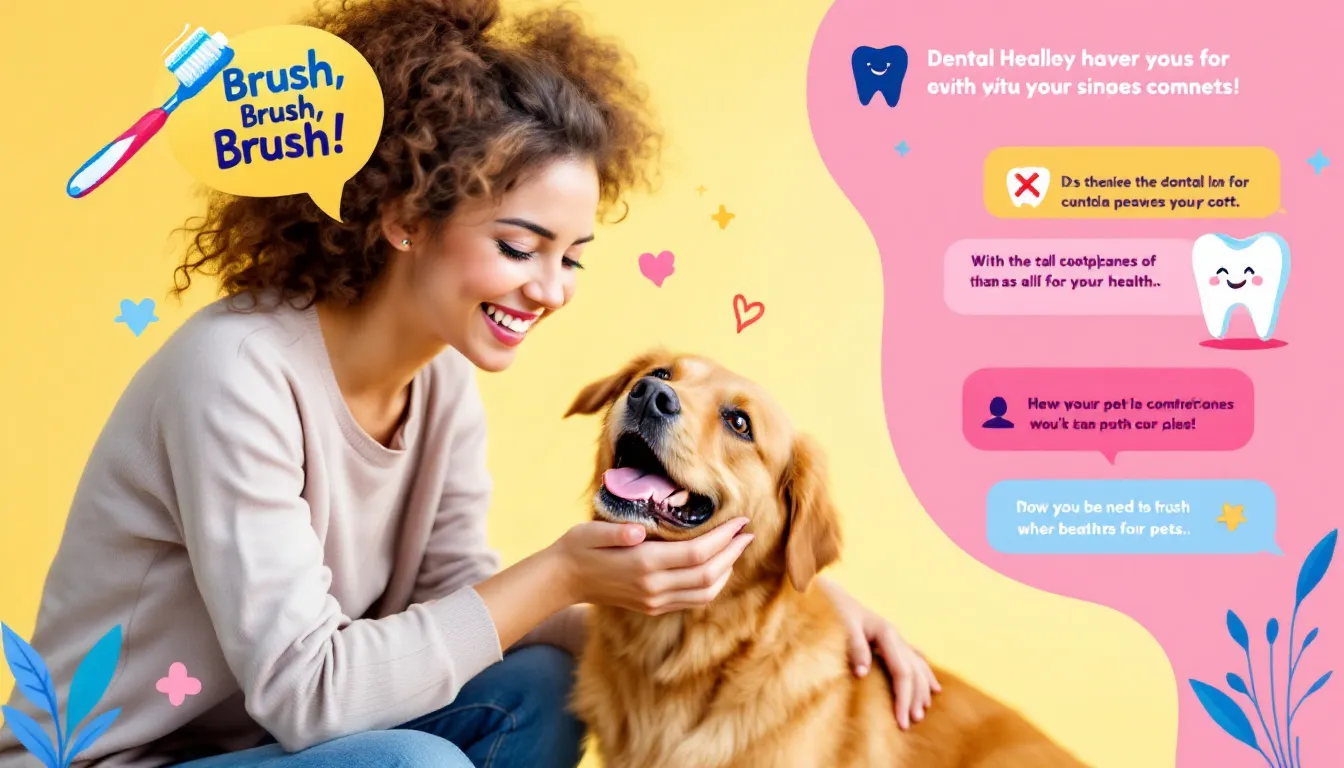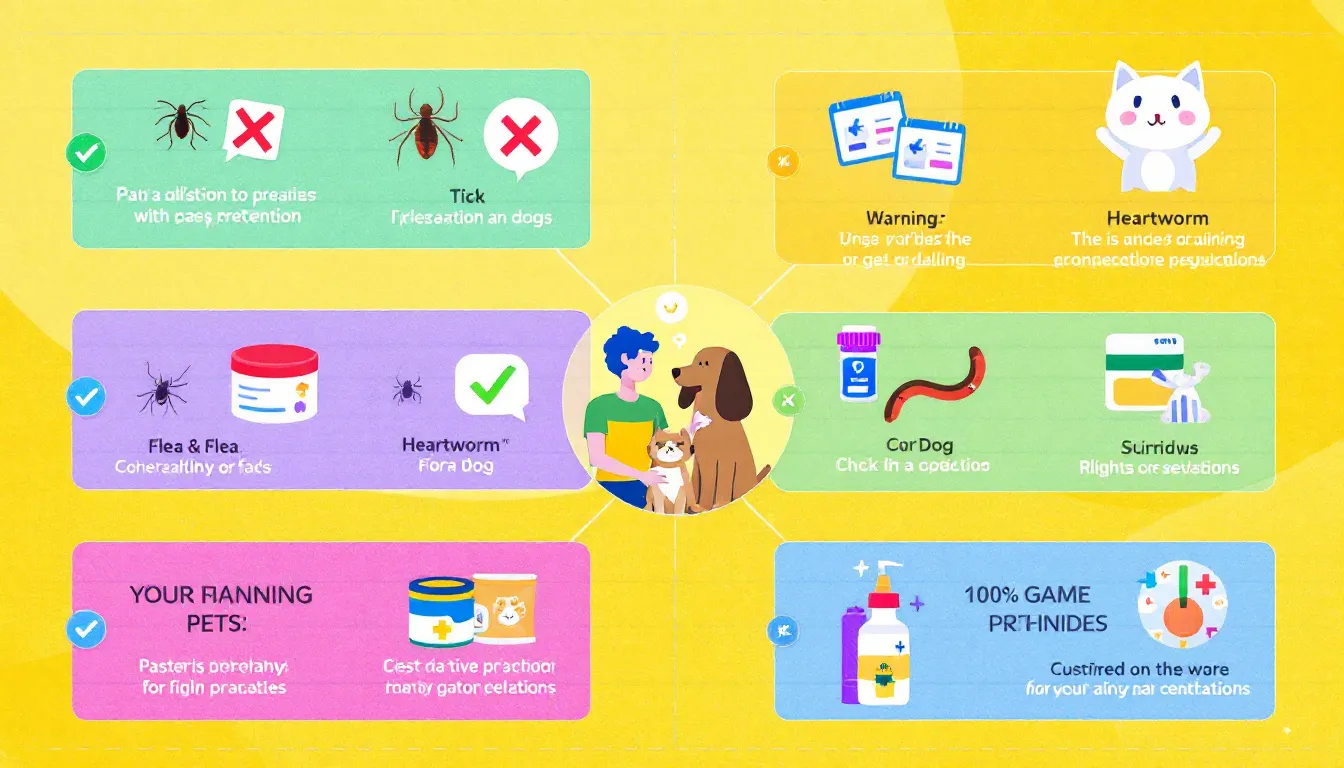Your pet’s year-round health matters. In this The Ultimate Guide to Keeping Your Pet Healthy Year Round, discover how to optimize vet visits, manage diet and nutrition, ensure regular exercise and mental stimulation, and maintain grooming and hygiene. This guide provides the complete roadmap for every season of your pet’s life.
Key Takeaways
-
Schedule regular vet visits to monitor health, catch issues early, and maintain your pet’s overall well-being.
-
A balanced diet and regular exercise are key to promoting your pet’s physical health, mental stimulation, and longevity.
-
Ensure a safe environment, prioritize emotional well-being, and stay vigilant about your pet’s behavior to support their happiness and health.
Schedule Routine Vet Visits

Routine vet visits are a cornerstone of responsible pet ownership, crucial for preventing diseases and maintaining your pet’s optimal health. These check-ups play a vital role in the early detection of health issues, allowing you to address them before they escalate. Establishing a health baseline during these regular vet visits allows for more accurate tracking of future changes, making routine care an essential part of your pet’s well-being.
Most pets should have wellness exams at least once a year, while senior pets or those with chronic issues may require check-ups every six months. Routine vet visits help keep your pet healthy and can save you from hefty veterinary bills in the long run.
Balanced Diet and Nutrition Management

A balanced diet is fundamental to your pet’s overall health and longevity. Quality nutrition enhances your pet’s quality of life and promotes long-term health. Choosing pet food that adheres to AAFCO standards and has undergone feeding trials ensures it meets your pet’s nutritional needs. Proper nutrition is key to a healthy diet and a healthy life for your pet.
Cats, for example, need a diet rich in meat because they cannot thrive on a vegetarian diet due to their unique nutritional requirements. As pets age, their nutritional needs change, and tailored life stage diets help meet these evolving requirements. Over-feeding, too many treats, and offering people’s food can lead to pets becoming overweight, which can adversely affect their health. Discuss diet options with your veterinarian to ensure the best nutritional plan for your pet.
Gradually transitioning to a new diet helps avoid gastrointestinal issues in pets. Recognizing individual pet requirements is essential for promoting complete wellness and weight management. Proper nutrition and balanced diets pave the way for a healthy life for your pet.
Regular Exercise and Physical Activity

Regular exercise keeps your pet healthy, both physically and mentally. Physical activity helps dogs maintain a healthy weight, reducing the risk of obesity-related health issues. It also improves cardiovascular health by enhancing circulation and increasing heart rate. Different breeds have varying exercise needs, with smaller dogs often requiring shorter, more frequent activities, while larger breeds may need more vigorous exercise sessions.
Puppies need frequent play and socialization to develop properly, while adult dogs require exercise tailored to their energy levels and health conditions. Allowing pets to explore and sniff during walks offers essential mental enrichment alongside physical exercise.
Mental engagement is equally critical for pets to maintain their joy and health. Incorporating puzzle toys, puzzle feeders, and interactive play toys encourages pets to think and problem-solve while engaging physically. Obstacle courses and scent games can be enjoyable ways for pets to engage both their physical and mental abilities.
Establishing regular exercise routines contributes to your pet’s overall wellness, ensuring a healthy, vibrant life.
Mental Stimulation and Enrichment
Mental stimulation is equally important as physical exercise for your pet’s mind. A lack of mental stimulation can lead to behavioral problems such as destructive behavior, mental distress, and mental stagnation, making a mental workout essential.
Regularly challenging your pet’s mind with new tasks and engaging activities can slow cognitive decline. Here are some effective ways to provide mental stimulation:
-
Using puzzle toys
-
Hiding treats
-
Setting up obstacle courses
-
Teaching new tricks
By incorporating these activities into your pet’s routine, you can help keep their mind sharp and engaged.
Participating in activities like fetch or agility training can stimulate a dog’s mind and prevent boredom-related issues. Senior pets can greatly benefit from mental stimulation through gentle training and puzzle toys, keeping their minds engaged.
Cats can enjoy scratching posts, which allow them to express their natural behaviors while protecting your furniture. Mental enrichment ensures your pet’s mental well-being.
Dental Health and Hygiene

Good oral hygiene prevents dental disease in pets. It also helps avoid potential systemic health issues. Poor dental hygiene can significantly affect a pet’s quality of life and contribute to long-term health problems, including gum disease. Dental chews can effectively reduce plaque build-up in dogs due to the mechanical action of chewing. Certain dental treats and diets can lower plaque levels by nearly 70%, promoting better oral health.
The Veterinary Oral Health Council (VOHC) recognizes products that meet specific standards for reducing dental issues. Regular dental care can prevent serious health risks linked to periodontal disease, improving overall pet health. It’s recommended that a pet’s mouth be examined at least once a year to catch any potential issues early. Statistics show that 70 to 80% of pets over the age of two exhibit signs of oral disease, underscoring the need for regular examinations.
In addition to an annual dental exam, a second dental exam later in the year is also recommended for optimal oral health monitoring. Prioritizing dental health and hygiene significantly contributes to keeping your pet healthy and happy.
Parasite Prevention Year-Round

Parasite prevention helps keep your pet healthy by preventing diseases caused by internal and external parasites. Year-round parasite prevention protects pets against fleas, ticks, and heartworms. Preventative medications for pets are used to avoid flea-related diseases, heartworms, and tick-borne illnesses.
Indoor pets can still get parasites easily, highlighting the need for constant vigilance in pet care. Regular grooming aids in the prevention of pests like fleas and ticks, which can infest both furry friends and homes.
Adopting a proactive approach to preventive healthcare and parasite prevention safeguards your pet against deadly diseases, ensuring long-term health.
Grooming and Skin Care
Regular grooming maintains your pet’s hygiene and overall well-being. Grooming activities such as brushing, regular baths, and trimming nails can improve your pet’s hygiene and skin health. Providing high-quality pet food can enhance skin and coat health, while excessive treats and human food can disrupt nutritional balance.
Routine grooming allows you to monitor your pet for skin and fur issues, helping you catch potential problems early. Prioritizing grooming and skin care significantly contributes to keeping your pet healthy and happy.
Monitoring Behavior and Health Status
Before:
Monitoring your pet’s behavior and pet’s health status is critical for early disease detection and overall well-being. Key indicators of good overall health in pets include a shiny coat and clear eyes. Other early signs are clean ears, a normal appetite, regular bowel movements, steady pet’s weight, active behavior, clean teeth, and fresh breath. Any major changes in a pet’s behavior or personality could be a sign of pain or illness and should be evaluated by a vet.
After:
Key indicators of good overall health in pets include:
-
A shiny coat
-
Clear eyes
-
Clean ears
-
A normal appetite
-
Regular bowel movements
-
Steady weight
-
Active behavior
-
Clean teeth
-
Fresh breath. Keeping pets healthy is essential for their well-being.
Any major changes in a pet’s behavior or personality could be a sign of pain or illness and should be evaluated by a vet.
Nutritional imbalances can lead to serious health complications such as allergies and organ diseases. Professional grooming helps in the early identification of potential health issues such as lumps and rashes. Vigilant monitoring ensures early detection and timely intervention for any health problems.
Creating a Safe and Comfortable Living Environment
Creating a safe and comfortable living environment is fundamental to responsible pet ownership. Using baby-proofing latches on drawers and cabinets can prevent pets from accessing harmful items. Keeping electrical cords hidden and organized can reduce the risk of pets chewing on them, which could lead to electric shocks.
Ensuring that trash cans are secured with locking lids can prevent pets from ingesting harmful waste. By viewing the home from a pet’s perspective, you can identify potential hazards and areas of interest that may pose risks.
Pet-proofing your home fosters a safe and comfortable environment for your pet’s well-being and promotes pet parenthood excellence, while also considering pet guardianship.
Emotional Well-Being and Stability
Emotional well-being significantly impacts your pet’s overall health. Here are some ways to enhance your pet’s emotional well-being:
-
Establish a stable routine to create a sense of security, reducing anxiety.
-
Provide extra affection to enhance the emotional well-being of senior pets.
-
Offer opportunities for socialization with new people and environments, which are vital for a pet’s mental wellbeing.
Activities that mentally stimulate pets can elevate their mood and reduce signs of depression. Engaging pets in play and providing a nurturing environment help alleviate their emotional distress. Focusing on emotional care ensures your pet’s mental and emotional well-being.
Spaying and Neutering
Spaying and neutering offer significant health and behavioral benefits for pets. Spaying female animals can help prevent uterine infections and lower the risk of breast cancer. Neutering male pets eliminates the chance of testicular cancer and decreases the risk of prostate issues. Spayed and neutered pets often have a longer lifespan on average compared to those that are not sterilized.
Behavioral changes from spaying and neutering include the reduction of mating behaviors and decreased roaming in males. Most vets agree that the benefits of spaying and neutering outweigh the risks. Opting for these procedures contributes to your pet’s health and improves their quality of life.
Pet Identification and Safety
Proper pet identification is crucial for increasing recovery chances if pets get lost. Microchipping pets increases the chances of recovery if lost by 2000%. The cost of microchipping is minimal, making it an affordable option for pet owners. Overall, microchipping enhances pet safety and is a recommended practice for all pet owners.
Ensuring your pet has proper identification significantly protects them and ensures their safety if they get lost.
Caring for Senior Pets
Caring for senior pets requires special attention to their changing needs. Senior pets often need to visit the veterinarian twice a year to detect health issues early, such as arthritis or heart disease. Diet for older pets should be adjusted; senior formulas typically have lower calories and higher fiber to support their changing nutritional needs.
Gentle exercise, like shorter but more frequent walks, is recommended to keep senior pets active without overexerting them. Creating a comfortable living space with orthopedic beds and non-slip rugs can help senior pets manage mobility challenges.
Focusing on these aspects ensures that your senior pets live their best lives in a comfortable and healthy life through a holistic approach.
Summary
In conclusion, keeping your pet healthy year-round requires a holistic approach that includes regular vet visits, balanced nutrition, exercise, mental stimulation, and emotional care. Each aspect of pet care plays a vital role in ensuring your pet’s overall well-being. By following these expert tips and best practices, you can provide your furry friends with the best lives possible.
Let’s commit to responsible pet ownership and take proactive steps to enhance our pets’ health and happiness. Remember, a healthy pet is a happy pet!
Frequently Asked Questions
How often should I take my pet to the vet for routine check-ups?
It's essential to take your pet for routine check-ups at least once a year; senior pets or those with chronic issues benefit from more frequent visits every six months. Prioritizing these check-ups ensures your furry friend stays healthy and happy!
What kind of diet is best for my pet?
Choosing a diet that meets AAFCO standards and has undergone feeding trials is crucial for your pet’s health. Work closely with your veterinarian to create the best nutritional plan for your furry friend!
How much exercise does my pet need?
Your pet's exercise needs vary by breed; smaller dogs benefit from shorter, frequent activities, while larger breeds require longer sessions. Make sure to cater to your pet's unique needs for a happy and healthy life!
What are the benefits of spaying and neutering my pet?
Spaying and neutering your pet not only protects them from serious health issues like cancer but also promotes better behavior, reducing unwanted mating and roaming. By making this choice, you're helping your furry friend live a healthier, happier life.
Why is microchipping important for my pet?
Microchipping your pet is crucial as it boosts the chances of recovery if they go missing by an incredible 2000%. It's an affordable step that ensures your furry friend has the best chance of coming back home safely!


